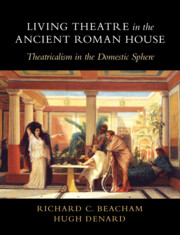Book contents
- Living Theatre in the Ancient Roman House
- Living Theatre in the Ancient Roman House
- Copyright page
- Dedication
- Contents
- Figures
- Acknowledgements
- Chapter 1 Roman Theatricality and Theatricalism
- Chapter 2 Theatrical Life at Pompeii
- Chapter 3 Performance at Pompeii and the Range of Roman ‘Theatrical’ Entertainments
- Chapter 4 Politics and Patronage at Pompeii
- Chapter 5 Theatricalism and the Roman House
- Chapter 6 Skenographia
- Chapter 7 Skenographia at Boscoreale, Oplontis and Pompeii
- Chapter 8 Skenographia on the Palatine and at Pompeii
- Chapter 9 Fourth Style Skenographia
- Chapter 10 Triclinium Theatricality
- Bibliography
- Index
Chapter 10 - Triclinium Theatricality
Published online by Cambridge University Press: 22 December 2022
- Living Theatre in the Ancient Roman House
- Living Theatre in the Ancient Roman House
- Copyright page
- Dedication
- Contents
- Figures
- Acknowledgements
- Chapter 1 Roman Theatricality and Theatricalism
- Chapter 2 Theatrical Life at Pompeii
- Chapter 3 Performance at Pompeii and the Range of Roman ‘Theatrical’ Entertainments
- Chapter 4 Politics and Patronage at Pompeii
- Chapter 5 Theatricalism and the Roman House
- Chapter 6 Skenographia
- Chapter 7 Skenographia at Boscoreale, Oplontis and Pompeii
- Chapter 8 Skenographia on the Palatine and at Pompeii
- Chapter 9 Fourth Style Skenographia
- Chapter 10 Triclinium Theatricality
- Bibliography
- Index
Summary
This chapter moves from painting to ’practice’. A particularly striking example both of theatricalised domestic space and activity is seen in the layout and decoration of dining rooms (triclinia), and in the range of entertainments presented within them. We examine how, responding to changes in the political, cultural and economic conditions of Roman society during this period, these private triclinium spaces and their decorative schemes were often systematic adaptations drawing upon the continuously evolving public discourse generated by theatrical entertainments. The chapter describes the range and nature of presentations that took place within the house, primarily as part of the dinner entertainments. Our focus is upon the likely venues as well as the decor of these spaces, and how, in combination, they created highly theatricalised and richly suggestive settings for performance and its reception. We include a detailed case study of the Pompeian House of Marcus Lucretius, detailing how these elements have been synthesised through the deployment of a pervasive theatricalism to create a highly appropriate setting for visitors as they move through its various rooms and spaces
Keywords
- Type
- Chapter
- Information
- Living Theatre in the Ancient Roman HouseTheatricalism in the Domestic Sphere, pp. 426 - 483Publisher: Cambridge University PressPrint publication year: 2023

